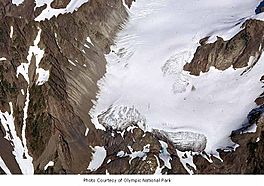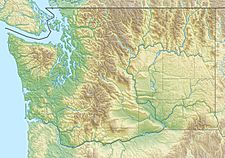Humes Glacier facts for kids
Quick facts for kids Humes Glacier |
|
|---|---|
 |
|
| Type | Mountain glacier |
| Coordinates | 47°47′22″N 123°39′02″W / 47.78944°N 123.65056°W |
| Length | 1.25 mi (2.01 km) |
| Terminus | Icefall and Talus |
Humes Glacier is a cool river of ice found in the Olympic Mountains in Olympic National Park, USA. It's about 2.25 miles (3.6 km) southeast of the top of Mount Olympus. This glacier starts high up, around 6,000 feet (1,829 meters) above sea level. It then flows downhill for about 1.25 miles (2 km), ending at 4,800 feet (1,463 meters) high.
Contents
What is Humes Glacier?
Humes Glacier is a type of glacier called a mountain glacier. This means it forms in high mountain areas. It slowly moves down the mountain, shaping the land as it goes. Glaciers are like giant, slow-moving ice sheets. They are made from layers of snow that get packed down over many years.
Where is Humes Glacier Located?
This amazing glacier is found in the Olympic Mountains. These mountains are part of Olympic National Park in Washington State, USA. The park is famous for its beautiful forests, mountains, and coastline. Humes Glacier is specifically located in Jefferson County, Washington.
How Big is Humes Glacier?
Humes Glacier is about 1.25 miles (2 kilometers) long. It starts at a high elevation of nearly 6,000 feet (1,829 meters). Then, it flows down the mountain. It ends at about 4,800 feet (1,463 meters) above sea level. The end of the glacier is called its terminus. Here, the ice can break off in an "icefall" or melt into piles of rock and dirt called "talus."
Who Named Humes Glacier?
Humes Glacier got its name in 1907. Members of a climbing group called The Mountaineers named it. They named it after two brothers, Grant and Will Humes. These brothers were important people in the area. They worked as guides, helping others explore the mountains. They also operated "pack-trains," which were groups of animals used to carry supplies.
Why are Glaciers Important?
Glaciers like Humes Glacier are very important for our planet. They store a lot of fresh water. When they melt slowly, they provide water for rivers and streams. This water is used by plants, animals, and even people. Glaciers also help scientists study Earth's climate. By looking at ice cores from glaciers, scientists can learn about past temperatures and atmospheres.


